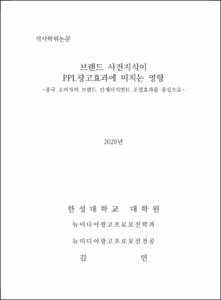브랜드 사전지식이 PPL광고효과에 미치는 영향
= The Influence of Brand Previous Knowledge on PPL Advertising Effects
- Type
- Thesis
- Alternative Title
- 중국 소비자의 브랜드 인게이지먼트 조절효과를 중심으로
- Department
- 대학원 뉴미디어광고프로모션학과
- Issued Date
- 2020
- Publisher
- 한성대학교 대학원
- Keyword
- 사전지식; 브랜드 인게이지먼트; PPL광고효과
- Appears in Collections:
- 뉴미디어광고프로모션학과 > 1. Thesis
- Files in This Item:
-
-
Download
 200000335705.pdf
기타 데이터 / 3.18 MB / Adobe PDF
200000335705.pdf
기타 데이터 / 3.18 MB / Adobe PDF
-
Items in Repository are protected by copyright, with all rights reserved, unless otherwise indicated.